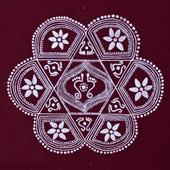Design Resource
Aipan - Uttarakhand
Ritual Floor Painting
by
Aipan ritual art is made on the floor and walls by drip drawn method. Aipan paintings are usually drawn on the floors, walls, the Chauki (on which a deity is placed), on pots containing the Tulsi plant, on Winnowing basket (made out of bamboo used for cleaning rice etc.) and at the entrance of homes, in the courtyard.
The tools and raw materials:
• Cow Dung: Cow dung solution is used as the base coat before red clay coating.
• Geru: Red clay solution applied on the floor as a base before painting the Aipan design.
• Rice Paste: Solution of rice paste and water through which Aipan design is painted.
• Brush: A painting brush is used to paint the Aipan motifs. Sometimes the handmade brushes are made with a simple bamboo stick and a piece of cotton wrapped on it.
The design process followed for making an Aipan is as below:
• As per the tradition, the floors and walls are first cleaned with cow dung liquid (cow dung mixed with water) to make the place dustproof. But in modern times all houses do not apply cow dung solution due to cemented walls and floorings it is done especially on the floors.
• Later when it dries one circle is made with Geru (red clay solution) on which Aipan work is done when it is fully dried.
• In the meantime, the rice is taken (which is soaked overnight) and ground into a fine paste (either with mortar or in a grinding machine) and checked for proper consistency. The rice paste should not be too slurry or too thick, it should be free-flowing.
• Once the coat of Geru is dried, the artisan swiftly draws the design patterns in rice paste using her finger.
The Tradition:
The Aipan is traditionally drawn for ceremonies of birth, marriage, and many other festivals throughout the year. The painting patterns differ for each ceremony, occasion and according to the deity.
The central design of the Aipan is considered as per the ritual and has a traditional motif while the outer design can be extended or reduced to fit the space (red color background). The dots or Bindu is an important element without which the Aipan is considered unfinished. Paintings drawn on the floor of the prayer room and on the deities’ seat has Tantric motifs called as Peetha or Yantra.
The kitchen’s wall is painted with animal motifs. At wedding times Aipans are made from Turmeric and Vermillion. The entrance to the home is decorated with good luck patterns and many times are just vertical white lines. These designs are nowadays painted on greeting cards, wall hangings and other products. Aipan is drawn by village women folk who make these beautiful designs. They pass on this tradition to their daughters and daughters-in-law, to preserve the culture.














